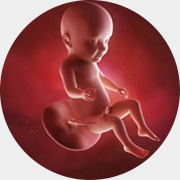Share Video:
Induction Abortion
Third Trimester
A third trimester induction abortion is performed at 25 weeks LMP (25 weeks since the first day of the woman’s last period) to term. At 25 weeks, a baby is almost fully-developed and is considered viable, meaning he or she could survive outside the womb. For this reason, the abortionist will usually first kill the baby in utero by injecting a substance that causes cardiac arrest, and induces the mother’s labor to deliver her baby stillborn.

Day 1: To help ensure the baby will be delivered dead and not alive, the abortionist uses a large needle to inject digoxin or potassium chloride through the woman’s abdomen or vagina, targeting the baby’s heart, torso, or head. When the digoxin takes effect, the lethal dose causes a fatal cardiac arrest, and the baby’s life will end. (Even if the needle misses the baby, digoxin can still kill the baby when released into the amniotic sack, but will usually take longer to kill the child.)
During the same visit, the abortionist inserts multiple laminaria sticks, or sterilized seaweed, to open up the woman’s cervix.
Day 2: The abortionist replaces the laminaria and may perform a second ultrasound to ensure that the baby is dead. If the child is still alive, the abortionist administers a second lethal dose of digoxin or potassium chloride. During this visit, the abortionist may administer labor-inducing drugs.
The woman goes back to where she is staying while her cervix continues to dilate. The woman will usually wait a period of two to four days for her cervix to dilate enough for her to deliver the dead baby.
Day 3 or 4: The woman returns to the clinic to deliver her dead baby. If she goes into labor before she can make it to the abortion clinic in time, she will deliver her baby at home or in a hotel room. During this time, a woman may be advised to sit on a bathroom toilet until the abortionist arrives. If she can make it to the clinic, she will do so during her most heavy and severe contractions and deliver the dead baby.
If the child does not come out whole, the procedure becomes a D&E, or a dilation and evacuation. The abortionist uses clamps and forceps to dismember and remove the baby piece by piece.1
- Darney, P.D., et al. “Digoxin to facilitate late second-trimester abortion: a randomized, masked, placebo-controlled trial.,” Obstetrics and Gynecology, Vol. 97, Issue 3, Mar.2001, pp. 471-476. <www.ncbi.nlm.nih.gov/pubmed/11239659>.
If a woman has been dilated with laminaria, but not yet undergone the surgical abortion, she can still change her mind. Depending on how much her cervix has dilated, there is a potential risk of miscarriage as dilation continues because her body may begin contractions and labor. A woman who changes her mind should immediately contact a medical professional to ensure the laminaria is properly removed.1
- Kaufman, K. The Abortion Resource Handbook.” New York: Fireside, 1997, 32, 153. <https://books.google.com/books?id=F7q3TB6_koYC&pg=PR18&dq=the+abortion+resource+handbook&hl=en&sa=X&ved=0ahUKEwjBpZvBxNrJAhUO42MKHchnCA4Q6AEIJjAA#v=onepage&q=the%20abortion%20resource%20handbook&f=false>.
After administration of the digoxin or potassium chloride, laminaria, and labor-inducing drugs, the woman often waits for labor at home or in a hotel. If she cannot make it to the abortion clinic in time for her delivery, she may be advised to call the abortion clinic and labor over the toilet. During this time, the woman does not have direct or immediate supervision.
A woman faces greater risks aborting her child in the late-term, given the child’s size and development. Late-term abortions have a high risk of hemorrhage, lacerations, and uterine perforations, as well as a risk of maternal death. Future pregnancies are also at a greater risk for loss or premature delivery due to abortion-related trauma and injury to the cervix.
There are studies that indicate the risk of depression, anxiety, and suicide is greater for a woman who aborts an unwanted pregnancy than it is for a woman who carries an unwanted pregnancy to term.1
- Fergusson, David M with Joseph M. Boden and L. John Harwood. “Does abortion reduce the mental health risks of unwanted or unintended pregnancy? A re-appraisal of the evidence.” Australian & New Zealand Journal of Psychiatry, Sept. 2013, Vol. 47, No. 9, pp. 819-827. <http://www.ncbi.nlm.nih.gov/pubmed/23553240>.
While some states have enacted prohibitions on abortion — including restricting the procedure after a certain point in pregnancy — other states permit abortions without exception.
At 25 weeks, a preborn child is fully developed and considered viable — that is, with proper medical care and attention, he or she would be able to survive outside of the womb. While medical staff is required to provide life-saving care to a child who survives an abortion procedure, it is unlikely that doctors and hospitals will take intensive measures to rescue the baby if it is born alive following an abortion procedure.1

Week 25
At twenty-five weeks LMP, the baby’s hair continues to grow, and the color and texture can be discerned. At this stage, the child is around 13 ½ inches long, from the baby’s head to its heels. Source: Baby Center.

Week 27
At twenty-seven weeks LMP, the preborn baby weighs almost two pounds. The child’s brain tissue continues to develop, and the baby is sleeping and waking in regular cycles. The mother may even feel the child hiccup at this stage, which may become more common as the pregnancy progresses. Source: Baby Center.

Week 31
At thirty-one weeks LMP, the baby can turn his or her head to the side, and is very active in the womb. The baby kicks and does somersaults, and develops more fat underneath the skin. Source: Baby Center.
- Grimes, David A. “Second-Trimester Abortions in the United States”, Family Planning Perspectives, Nov./Dec. 1984, 260-266.

Please note: This website has been researched and reviewed by physicians for medical accuracy; however, it is not intended to constitute medical advice or replace the individualized counsel of a doctor.
